
We are testing the 178cm Black Crows Mentis Freebird: an 80mm underfoot ski, near the 1kg lightweight standard, and a bossy 19m turning radius.
WildSnow visited Black Crows HQ in Chamonix back in 2020. That story begins a bit like this ski review: with the marketing. “I don’t know what it is,” a member of Black Crows’ marketing crew said upfront in that piece. “There’s a fandom around the skis. People just go crazy for them.”
Maybe if you spend years cocooned inside the Chamonix-based ski maker’s HQ, there might be some confusion as to why the brand has exploded in the fifteen years since Camille Jaccoux and Bruno Compagnet began tinkering with ski design. But for others, the popularity begins with savvy marketing: Black Crows has mastered that. Their skis and logos are catchy. The touring inspired Freebird line’s ski bases are brightly colored; lime green for the Navis Freebird, hot pink for the Corvus Freebird, and in the case of the Mentis Freebird, a mod-squad blue seafoam (Black Crows calls it ice blue). The top sheets on all these models mirror the glamorous bases in hue.
Each ski in the line comes with a sassy, often sexualized, motto along the sidewalls. In the case of the Mentis I’m testing, that’s “sensual dancing,” also in a cool font, BTW. (“Sensual dancing,” is also the motto for the Corvus Freebird, according to Black Crows’ website.) Also, according to their website, the Mentis’ motto should read, “yesterday i ate a whole pizza.”
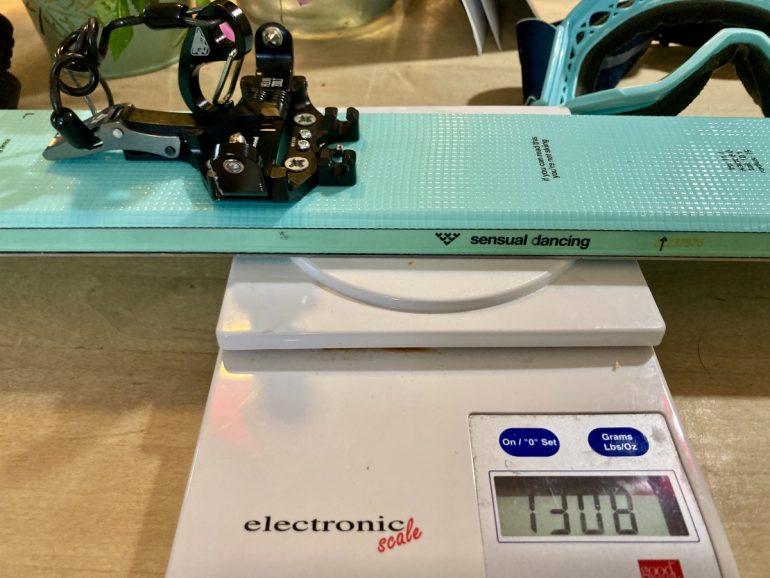
The Black Crows Mentis Freebird with a BD Helio 200 LT binding and adjustments plates weighs in at 1308g. The skis, without bindings weighed 1054g and 1070g, respectively. Go ahead, eat a pizza.
The cynic in me thinks the mottos change with the manufacturing run. So motto scarcity generates motto lust. Kind of like a limited-run Cabbage Patch kid – ask your parents about it. The bottom line is that good marketing sells. That is a fact. But good marketing has a finite and short life expectancy among discerning backcountry skiers. If the skis stink, we know how the story ends.
Skier feedback to Black Crows skis, for the most part, are glowing. But, I’ve avoided the very tempting line of Freebird skis for a few reasons. I’m averse to blatant marketing, and when looking for a 100+ underfoot ski, their Navis Freebird (179cm, 1675 gram per ski) and Corvus Freebird (183cm, 1950g per ski) were just tipping the scales on the too heavy side. I’ve heard they kill on the descents, but I’ve got to get those skis up there first. (We’ll have an initial review of the Corvus Freebird in the next week or so.)
However, that ongoing glowing feedback from the tribe kept my ear tuned, barely, to the Black Crows’ pied piper. Ultimately, here’s the tune that sang to me: 80mm underfoot, a smidge over 1000g in weight, and a 19m turn radius.
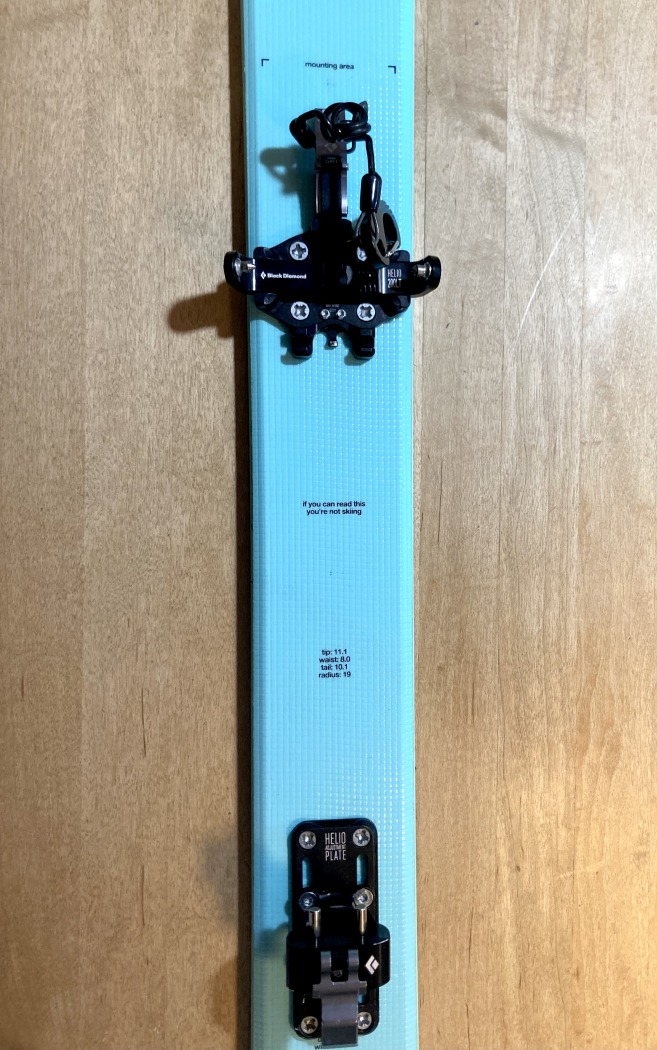
The binding mount area on the Mentis is reinforced with a titanal plate.
Historically, I’ve trended shorter and lighter for a spring ski mountaineering ski, like many. I’m testing the 178cm Mentis Freebird as a ski that I aim to take on deep spring missions and potential traverses with occasional steep descents. I was on a 170cm 79mm underfoot and 18m turn radius Salomon X Alp for a few years. That ski was solid, ate up the vertical and kilometers, and was trusty on icy descents. I also ski a 170cm Hagan Ultra 82 – as the name suggests, it’s 82mm underfoot. The Ultra 82’s tip (117mm) is a bit wider than the X Alp tip (113mm), and shares a similar turn radius. Both models are alike in weight to the Mentis. I recently sold the X Alps for no other reason than to make room and hung onto the Hagans – they have been trusty.
Despite the X Alps and Ultra 82s claiming a turning radius around 18m, I found both pairs eager to make tighter, shorter, precise turns. Not bad characteristics in skinny chutes or slow-go descents with a 35 – 40 pound pack on a traverse. Yet, I prefer longer and higher speed turns most often. My thinking was that a slightly longer spring ski would facilitate those longer turns. Thus, the extra 8 centimeters, making for a 178cm ski with the Mentis.
The weight stats are this: One Mentis weighs 1054g, the other 1070g. I mounted Black Diamond Helio 200 LT bindings with adjustment plates and leashes. It is a relatively light setup. They punch up into the +1300g class at roughly 1308g per ski with bindings aboard. So far, I’m matching them with a Fischer 1st gen Carbon Travers boot.
First, a few notes about turning the Mentis on icier tracks after uphilling at the area. The ski bites into firm snow, even icy slopes, with confidence. That confidence does not disappear at speed. The extra length, in my estimation, provides a bit more running length to power into and out of a GS-style turn while schussing at a good clip. So fun. There is no BS here; the skis do not hesitate to arc through big turns, which feel true to, if not greater than, their prescribed 19m turn radius.

With the skis placed togther, a gentle and unagressive tip rise is noticeable.
They feature a traditional camber and a wee bit of tip rocker. Speaking of the tip shape, that too is stylized: it is not conventional, it’s squared off slightly. See the pic.
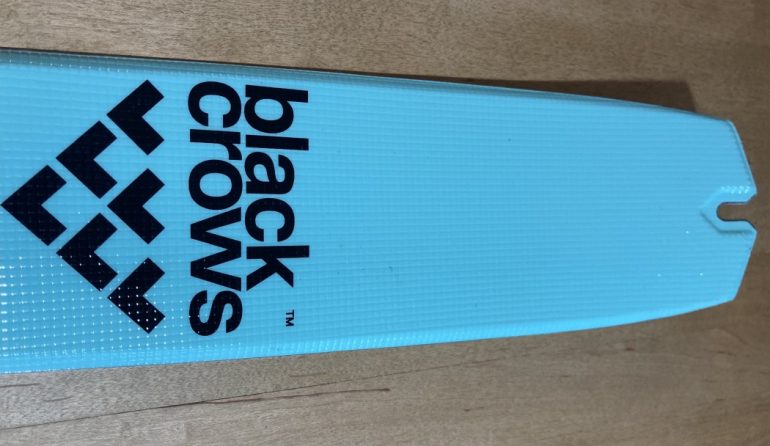
Take note, it’s hard not to: the Mentis’ ski tips are shaped just a bit differently. The tips are also notched for race style skin tip attachments.
On a lighter ski like the Mentis, which has some carbon in the layup, I expected a bit more tip chatter and some wash-out as I rounded out across the fall line. I experienced nothing of the sort. The Mentis is a skinnier and lighter ski wanting to open it up. For a strict resort uphilling ski, I’d say if you prefer longer turns on groomers in a svelte package, this might be a supreme choice. Remember, I sized up from my usual 170cm length to a 178cm in this instance.
The skiing sensations I describe align with the construction. With a Paulownia wood core, carbon fiber layer, fiberglass weave, near full ABS sidewalls, and a titanal plate in the binding mount zone, these are no skinny, chattery noodles. They ski smooth for what they are and have changed my perception of how an 80mm underfoot ski should handle.
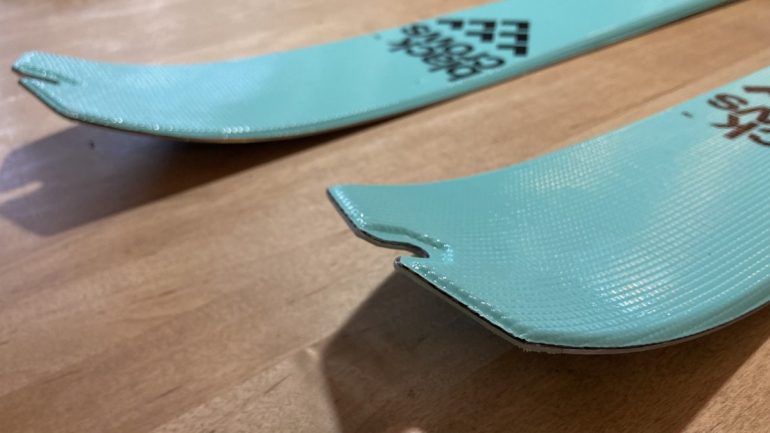
A close up view of the tips showing the notch and more blunt shape.
As far as skin attachments, the Mentis is notched in the tip for more race-oriented skin tip attachment systems and notched in the tail. However stylized that tail notch is, it’s cut out like the iconic Black Crows’ chevron design; it’s just not big enough for a Pomoca tail clip to sit firmly in unless the skin is sufficiently tightened. (I’ve had a skin tail pop off once.)
The pre-cut Black Crows’ skins for the Mentis are race-centric; there’s no tail clip. I’ll stick with a tail clip system in the spring for more security. However, I have used Pomoca Race Pro 2.0 Skins on the Mentis on long non-turn oriented tours this winter and resort uphilling. They work great. Those skins are designed for skis more in the 65mm underfoot range. Otherwise, I’m using Pomoca’s Climb 2.0 skins on the Mentis with a Dynafit rubber tip which sits nicely in the Mentis’ tip notch.
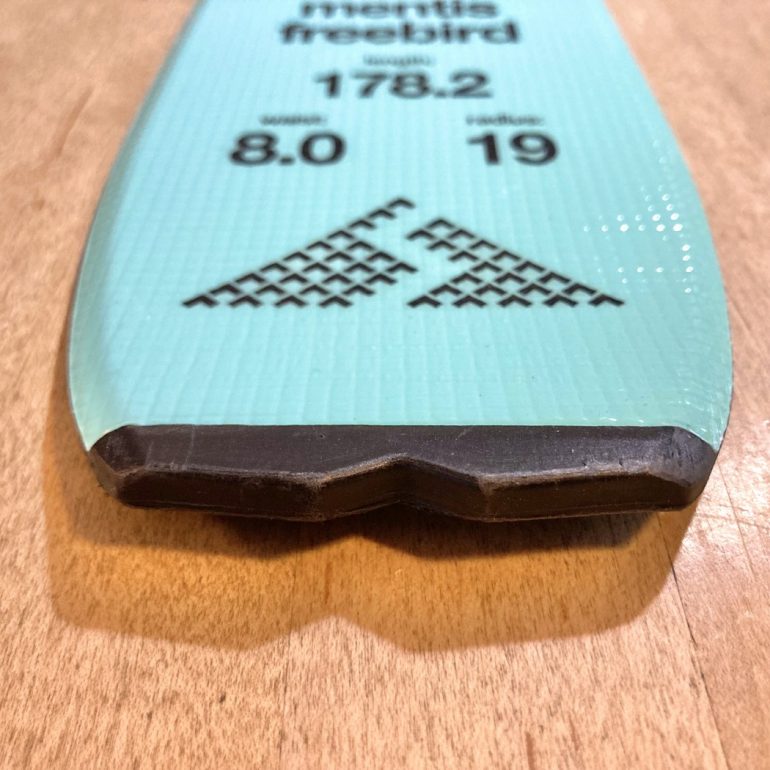
The tail is reinforced for durability. However, the notch for skins, if we want to call it that, is a small chevron. Pomoca’s tail clips, if succiently tightened, seem to sit snuggly in place.
It is trending towards mid-winter here, so taking the Mentis out in real-world mountain conditions suitable for this ski have been limited. Sad for the powder boards, and lucky for this review, we have had high pressure. This means freeze-thaw, maybe a smidge of corn/soft snow on east and south-facing slopes, along with some wind board and variable snow on a north-facing leeward face I skied on Saturday.
As expected, controlling the Mentis in a thin layer of soft sun-cooked snow was pretty easy. But, we are not talking about a super wide-tipped ski, so the shovel was pushed around slightly when not carrying speed.
The swing weight while jump turning on firm wind board was feathery. The edge hold I had previously experienced on-piste was confirmed. That wind board morphed slightly into more variable breakable snow about 150 meters below the ridgeline. The turns in this snow took more effort, as the skinnier tails grabbed if my weight transferred towards my heels. Survival turns? Not exactly, but I became more focused.
I took the Mentis out as I was freelancing on that day, looking to cover some kilometers and vert for fitness and make some turns in low consequence terrain. Also, it’s been a few weeks since a snow-refreshing storm has cycled through. I wasn’t interested in carrying extra weight.
So far, it is perhaps the dampest feeling lightweight ski I’ve been on. Is it a powder slayer? Nope. A broken crust layer slayer? Nope. An uphill-oriented ski capable of wide and stable and high-speed turns? Yes. As far as my limited time in the backcountry, the Mentis seem worthy for pre-dawn starts and headlamp finishes in the spring.
We’ll have a long-term review of the ski this spring.
The basics:
Price: $879.95
Weight: approximately 1060g (178cm).
Lengths: 157, 164, 171, 178 cm.
Dimensions: 111mm, 80mm, 101mm (178cm) Turn radius 19m.
Profile: Slight Rocker Tip / traditional camber.
Construction: Semi Cap, near full ABS sidewall.
Core: Paulownia, minimal carbon, and fiberglass.
Buy the Black Crows Mentis Freebird.
Jason Albert comes to WildSnow from Bend, Oregon. After growing up on the East Coast, he migrated from Montana to Colorado and settled in Oregon. Simple pleasures are quiet and long days touring. His gray hair might stem from his first Grand Traverse in 2000 when rented leather boots and 210cm skis were not the speed weapons he had hoped for. Jason survived the transition from free-heel kool-aid drinker to faster and lighter (think AT), and safer, are better.
